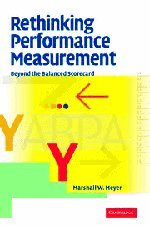
Rethinking performance measurement : beyond the balanced scorecard PDF
Preview Rethinking performance measurement : beyond the balanced scorecard
Rethinking Performance Measurement Performancemeasurementremainsavexingproblemforbusinessfirmsand otherkindsoforganizations.Thisbookexplainswhy:theperformancewe wanttomeasure(long-termcashflows,long-termviability)andtheperfor- mancewecanmeasure(currentcashflows,customersatisfaction,etc.)are not the same. The “balanced scorecard,” which has been widely adopted byUSfirms,doesnotsolvetheseunderlyingproblemsofperformancemea- surementandmayexacerbatethembecauseitprovidesnoguidanceonhow to combine dissimilar measures into an overall appraisal of performance. Ameasurementtechniquecalledactivity-basedprofitabilityanalysis(ABPA) is suggested as a partial solution, especially to the problem of combining dissimilar measures. ABPA estimates the revenue consequences of each ac- tivityperformedforthecustomer,allowingfirmstocomparerevenueswith costsfortheseactivitiesandhencetodiscriminatebetweenactivitiesthatare ultimatelyprofitableandthosethatarenot. marshall w. meyerisRichardA.SappProfessorandProfessorofMan- agementandSociologyatTheWhartonSchooloftheUniversityofPennsyl- vania. Rethinking Performance Measurement Beyond the Balanced Scorecard marshall w. meyer TheWhartonSchool,UniversityofPennsylvania CAMBRIDGE UNIVERSITY PRESS Cambridge, New York, Melbourne, Madrid, Cape Town, Singapore, São Paulo, Delhi Cambridge University Press The Edinburgh Building, Cambridge CB2 8RU, UK Published in the United States of America by Cambridge University Press, New York www.cambridge.org Information on this title: www.cambridge.org/9780521103268 © Marshall W. Meyer 2002 This publication is in copyright. Subject to statutory exception and to the provisions of relevant collective licensing agreements, no reproduction of any part may take place without the written permission of Cambridge University Press. First published 2002 Reprinted 2004 This digitally printed version 2009 A catalogue record for this publication is available from the British Library ISBN 978-0-521-81243-6 hardback ISBN 978-0-521-10326-8 paperback Contents Listoffigures pagevii Listoftables x Preface xi Introduction 1 1 Whyareperformancemeasuressobad? 19 2 Therunningdownofperformancemeasures 51 3 Insearchofbalance 81 4 Fromcostdriverstorevenuedrivers 113 5 LearningfromABPA 145 6 ManagingandstrategizingwithABPA 168 Notes 187 Index 198 v Figures I.1 Theperformancechainofthefirm page10 1.1 Locationintimeofthreetypesofperformance 23 1.2 Shiftingthetimeframebackward 23 1.3 UnitedWaythermometer 25 1.4 Thesevenpurposesofperformancemeasures 31 1.5 Organizationaldesignandperformancemeasuresof unitaryandmultiunitfirms 39 1.6 Measurescirca1960 44 1.7 Measurescirca1990 45 2.1 Differencesbetweenmeanbattingaveragesandbatting averagesforhighestandlowest10percentofmajor leagueplayers 53 2.2 Standarddeviationofbattingaveragebyyear 54 2.3 Averagelengthofpatientstayforvoluntary,for-profit, andgovernmenthospitalsbyyear 55 2.4 Averagecostperin-patientdayforvoluntary,for-profit, andgovernmenthospitalsbyyear 56 2.5 Occupancyratesforvoluntary,for-profit,and governmenthospitalsbyyear 57 2.6 Numberofscramsfortenbestandtenworstnuclear plants 58 2.7 Numberofsafetysystemactuationsfortenbestandten worstnuclearplants 58 2.8 Standarddeviationsofyields,allMMMFs 63 2.9 Standarddeviationsofyields,primecorporate MMMFs 64 2.10 Standarddeviationsofyields,highyieldMMMFs 64 2.11 MarketbetasbylogarithmofcompanyageforIPOs, July1977–December1984 66 2.12 Unsystematicvariancebylogarithmofcompanyagefor IPOs,July1977–December1984 67 vii viii Listoffigures 2.13 Twenty-daytotalvariancebylogarithmofcompany ageforIPOs,July1977–December,1984 67 2.14 Returnonassetsforcommercialbanks 70 3.1 1992businessmodelforGFSUSretailoperations 84 3.2 BalancedscorecardforGFSUSretailoperations, 1996 88 3.3 FlowchartofPIP 91 3.4 Flowchartofbalancedscorecard 92 3.5 BusinessmodelofGFSWesternregion(using branch-qualityindex) 98 3.6 BusinessmodelofGFSWesternregion(using componentsofbranch-qualityindex) 99 3.7 Theelementsofbalance 102 3.8 Decompositionofearnings 110 3.9 BalanceandfeerevenuesforeighteenEasternregion andtwelveWesternregionbranches,July–December 1999 111 4.1 Theimpactofactivitiesoncustomerrevenues 116 4.2 Separatingcostdriversfromrevenuedrivers:theneed forproductspecifications 118 4.3 ABPAconnectscustomertransactions,activitycosts, andcustomerprofitability 123 4.4 UsingABPAtoestimatetheimpactoftransactionand productutilizationoncustomerprofitability 126 4.5 Thecostandrevenueconsequencesofproblem resolutionactivity 132 4.6 Businessmodeloftheinjury-freeworkplace 143 5.1 ABPAscreens 152 5.2 ActionimplicationsofABPA 153 5.3 Improvecustomerrevenuesandprofitability 157 5.4 Recalibratebands 158 5.5 Tradeoffsbetweeneaseofimplementationandquality ofmeasurement 165 6.1 OrganizationaldesignforimplementingABPA: transactionflows 170 6.2 OrganizationaldesignforimplementingABPA: informationflows 171 6.3 OrganizationaldesignforimplementingABPA: administrativehierarchyandaccountabilities 171 Listoffigures ix 6.4 Late-1960smodelofmanufacturingfirm:coreis bufferedfromtheenvironment 174 6.5 Mid-1980smodelofmanufacturingfirm:core isexposedtoenvironment 175 6.6 Organizationandmetricsofwebportals 177 6.7 Tradeoffsbetweenlow-costanddifferentiation strategies 179 6.8 Limitsofmasscustomizationanddistributed networkstrategies 180 6.9 HowABPAconnectslow-costanddifferentiation strategies 182 6.10 Thechangingsignificanceofthebalanced scorecard 184 Tables 1.1 Everydaynotionsofperformanceandperformance measures page21 1.2 Typesofmeasuresbylocusandpurposesserved 35 3.1 EvolutionofthePIPSystem,1993–1995 93 4.1 CountryAqualitymeasures 129 4.2 ProblemincidenceandproblemresolutioninLatin Americanmarkets 134 5.1 Comparisonoffinancialmeasures,thebalanced scorecard,andABPA 161 x
